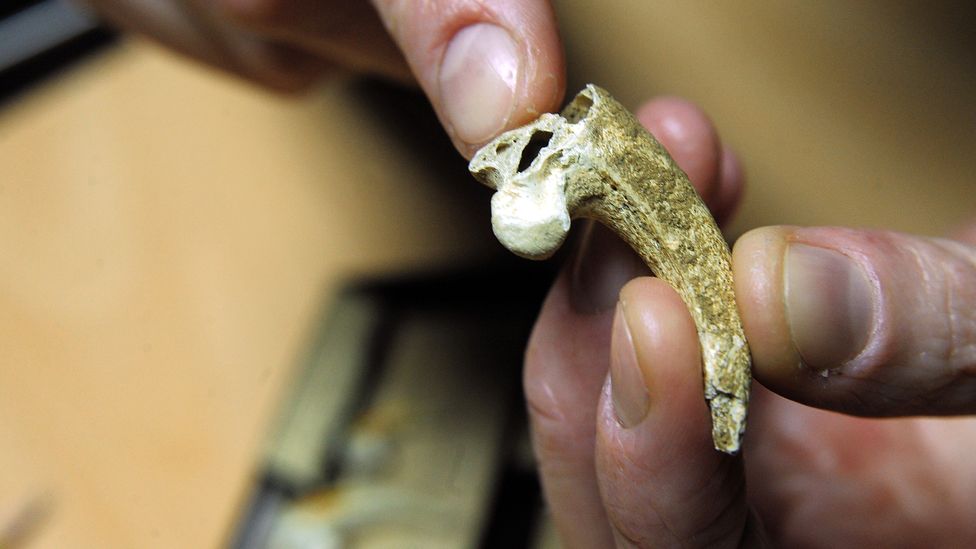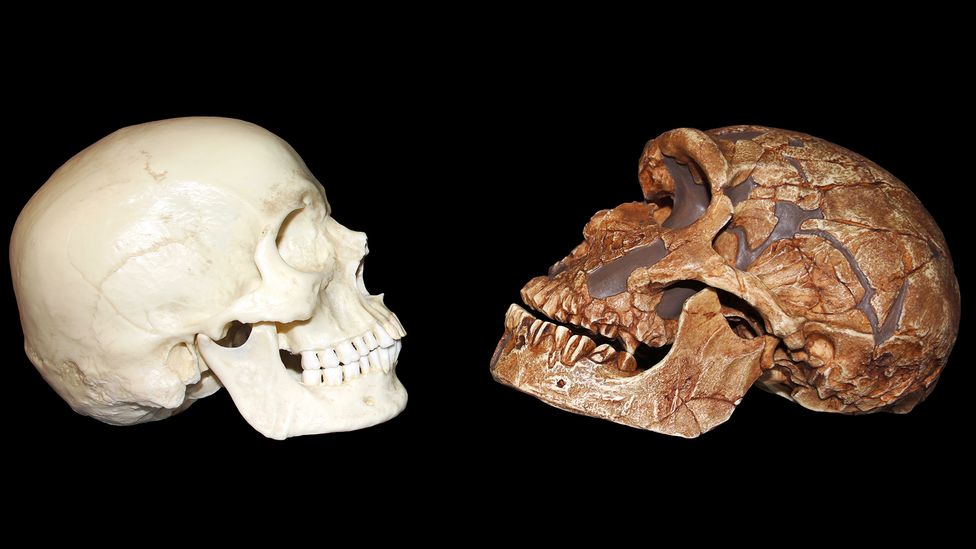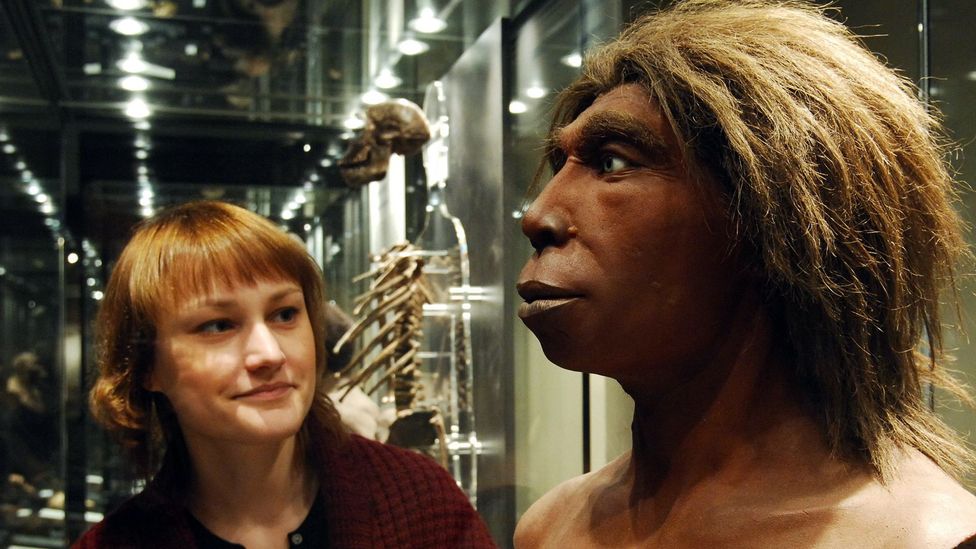Their eyes met across the rugged mountain landscape of prehistoric Romania.
He was a Neanderthal, and stark naked apart from a fur cape. He had good posture and pale skin, perhaps reddened slightly with sunburn. Around one of his thick, muscular biceps he wore bracelet of eagle-talons. She was an early modern human, clad in an animal-skin coat with a wolf-fur trim. She had dark skin, long legs, and her hair was worn in braids.
He cleared his throat, looked her up and down, and – in an absurdly high-pitched, nasal voice – deployed his best chat-up line. She stared back blankly. Luckily for him, they didn’t speak the same language. They had an awkward laugh and, well, we can all guess what happened next.
Of course, it could have been far less like a scene from a steamy romance novel. Perhaps the woman was actually the Neanderthal and the man belonged to our own species. Maybe their relationship was of the casual, pragmatic kind, because there just weren’t many people around at the time. It’s even been suggested, too, that such hook-ups weren’t consensual.
While we will never know what really happened in this encounter – or others like it – what we can be sure of is that such a couple did get together. Around 37,000-42,000 years later, in February 2002, two explorers made an extraordinary discovery in an underground cave system in the southwestern Carpathian mountains, near the Romanian town of Anina.
Even getting there was no easy task. First they waded neck-deep in an underground river for 200m (656ft). Then came a scuba dive for 30m (98ft) along an underwater passage, followed by a 300-metre (984ft) ascent up to the poarta, or “mouse hole” – an opening through which they entered a previously unknown chamber.
Inside the Peştera cu Oase, or "Cave with Bones", they found thousands of mammalian bones. Over its long history, it’s thought to have primarily been inhabited by male cave bears – extinct relatives of the brown bear – to which they largely belong. Resting on the surface among them was a human jawbone, which radiocarbon dating revealed to be from one of the oldest known early modern humans in Europe.

One tryst between our early modern humans ancestors and Neanderthals could have taken place in the Southern Carpathian mountains (Credit: NPL/Alamy)
The remains are thought to have washed inside the cave naturally and lain undisturbed ever since. At the time, scientists noticed that – while the jawbone was unmistakeably modern in its appearance, it also contained some unusual, Neanderthal-like features. Years later, this hunch was confirmed.
When scientists analysed DNA extracted from the find in 2015, they found that the individual was male, and likely to have been 6-9% Neanderthal. This is the highest concentration ever encountered in an early modern human, and around three times the amount found in present-day Europeans and Asians, whose genetic makeup is roughly 1-3% Neanderthal.
Because the genome contained large stretches of uninterrupted Neanderthal sequences, the authors calculated that the jaw’s owner is likely to have had a Neanderthal ancestor as recently as four to six generations ago – equivalent to a great-great-grandparent, great-great-great-grandparent or great-great-great-great grandparent. They determined that the liaison probably occurred fewer than 200 years before the time he lived.
In addition to the jawbone, the team found skull fragments from another individual at Peştera cu Oase, who possessed a similar mixture of features. Scientists have not yet been able to extract DNA from these remains, but like the jawbone, it’s thought that they may have belonged to someone who had recent Neanderthal ancestry.
Since then, the evidence that sex between early modern humans and Neanderthals was not a rare event has been mounting up. Hidden in the genomes of present-day populations, there are tell-tale signs that it happened on many separate occasions and across a wide geographical area. To this day, there are people carrying genetic material from at least two different populations of Neanderthals, which one analysis suggests interbred with humans several times in both Europe and Asia.
You might also like:
- How did the last Neanderthals live?
- The weird future of life on Earth
- Was human evolution inevitable?
In fact, Neanderthal DNA can be found in everyone alive today, including people of African descent, whose ancestors aren’t thought to have come into contact with this group directly. And the transfer also happened the other way around. In 2016, scientists discovered that Neanderthals from the Altai mountains in Siberia may have shared 1-7% of their genetics with the ancestors of modern humans, who lived roughly 100,000 years ago.
Crucially, though you might think the salacious details of these ancient liaisons have been lost to pre-history, there are still clues as to what they might have been like around today. Here’s everything you’ve ever wanted to know about this titillating episode in human history.
Kissing
In 2017, Laura Weyrich – an anthropologist at Pennsylvania State University – discovered the ghostly signature of a microscopic 48,000-year-old hitchhiker clinging to a prehistoric tooth.
“I look at ancient microbes as a way of learning more about the past, and dental calculus is really the only reliable way to reconstruct the microorganisms that lived within ancient humans,” says Weyrich. She was particularly interested in what Neanderthals were eating and how they interacted with their environment. To find out, she sequenced DNA from the dental plaque on teeth found in three different caves.
Two of the samples were taken from among 13 Neanderthals found at El Sidrón in north-west Spain. The site was recently beset by intrigue, when it was revealed that many of these individuals seem to have suffered from congenital abnormalities, such as misshapen kneecaps and vertebrae, and baby teeth which had remained long after childhood. The group is suspected to have been composed of close relatives, who had accumulated recessive genes after of a long history of inbreeding. The family met an unfortunate end – their bones are etched with tell-tale signs that they were cannibalised. It’s thought that they were among the last Neanderthals to walk the Earth.
To Weyrich’s surprise, one of the teeth from El Sidrón contained the genetic signature of a bacteria-like microorganism, Methanobrevibacter oralis, which is still found in our mouths to this day. By comparing the Neanderthal version with the modern human version, she was able to estimate that the two had drifted apart around 120,000 years ago.
If Neanderthals and present-day humans had always shared the same oral companions, you would expect this to have happened much, much earlier – at least 450,000 years ago, when the two subspecies took different paths. “What this means is that the microorganism has been transferred since then,” says Weyrich.
It’s impossible to know for sure how this happened, but it could be linked to something else that occurred 120,000 years ago. “For me what’s fascinating is this is also one of the first time periods where we have described interbreeding between humans and Neanderthals,” says Weyrich. “So it's wonderful to see a microbe sort of being wrapped up in that interaction.”
Weyrich explains that one possible route for the transfer is kissing. “When you kiss someone, oral microbes will go back and forth between your mouths,” she says. “It could have happened once but then sort of been somehow magically propagated, if it happened that the group of people who were infected went on to be very successful. But it could also be something that occurred more regularly.”
Another way to transfer your oral microbes is by sharing food. And although there is no direct evidence of a Neanderthal preparing a meal for an early modern human, a romantic meal could have been an alternative source of M. oralis.
For Weyrich, the discovery is exciting because it suggests that our interactions with other types of humans long ago have shaped the communities of microorganisms that we carry around today.
This raises a question for Weyrich: “Is our microbiome working correctly because we picked up microorganisms from Neanderthals?”
For example, while M. oralis tends to be associated with gum disease in modern humans, Weyrich says that it’s been found in lots of prehistoric individuals who had perfectly healthy teeth. In the future, she envisages using the insights gleaned from ancient dental plaque to reconstruct healthier oral microbiomes for people living in the modern world.
Male or female Neanderthals
It’s impossible to say for certain whether it was mostly female Neanderthals scoring with early modern human males, or the other way around – but there are some clues.
In 2008, archaeologists discovered a broken finger bone and single molar tooth in the Denisova Cave in Russia’s Altai Mountains, from which a brand new subspecies of human was revealed. For years, the “Denisovans” were known only from the handful of samples unearthed at this site, along with their DNA, from which scientists discovered that their legacy continues to this day in the genomes of people of East Asian and Melanesian descent.

Around 130,000 years ago, a Neanderthal in what is now Croatia sliced the talon off the toe of an eagle – possibly to make jewellery (Credit: STR/AFP/Getty Images)
Denisovans were a lot more closely related to Neanderthals than present-day humans; the two subspecies may have had ranges that overlapped in Asia for hundreds of thousands of years. This became particularly apparent in 2018, with the discovery of a bone fragment which belonged to a young girl – nicknamed Denny – who had a Neanderthal mother and Denisovan father.
Consequently, it would make sense if the male sex chromosomes of Neanderthals looked similar to those of Denisovans. But when scientists sequenced the DNA from three Neanderthals, who lived 38,000-53,000 years ago, they were surprised to discover that their Y chromosomes had more in common with those of present-day humans.
The researchers say this is evidence of "strong gene flow” between Neanderthals and early modern humans – they were interbreeding rather a lot. So often, in fact, that as Neanderthal numbers dwindled towards the end of their existence, their Y chromosomes may have gone extinct, and been replaced entirely with our own. This suggests that a substantial number of ancestral human men were having sex with female Neanderthals.
But the story doesn’t end there. Other research has shown that almost exactly the same fate befell Neanderthal mitochondria – cellular machinery that help to turn sugars into useable energy. These are exclusively passed down from mothers to their children, so when early modern human mitochondria were found in Neanderthal remains in 2017, it hinted that our ancestors were also having sex with male Neanderthals. This time, the interbreeding is likely to have happened between 270,000 and 100,000 years ago, when humans were mostly confined to Africa.
Sexually transmitted diseases
A few years ago, Ville Pimenoff was studying the sexually transmitted infection human papillomavirus (HPV) when he noticed something odd.
Papilloma viruses are ubiquitous among animals, including bears, dolphins, turtles, snakes and birds – in fact, they’ve been found in almost every species that has been studied for their presence. Among humans alone, there are more than 100 different strains in circulation, which are collectively responsible for 99.7% of cervical cancers worldwide. Of these, one of the deadliest is HPV-16, which is able to linger in the body for years as it quietly corrupts the cells that it infects.
But there is a clear divide globally between where certain variants of this virus are found. Across the majority of the planet, it’s most likely you’ll encounter type A, while in sub-Saharan Africa most people are infected with types B and C. Intriguingly, the pattern exactly matches the distribution of Neanderthal DNA worldwide – not only do people in sub-Saharan Africa carry unusual strains of HPV, but they carry relatively little Neanderthal genetic material.
To find out what was going on, Pimenoff used the genetic diversity among type A today to calculate that it first emerged roughly 60,000 to 120,000 years ago. This makes it much younger than the other kinds of HPV-16 – and crucially, this happens to be around the time that early modern humans emerged from Africa, and came into contact with Neanderthals. Though it’s hard to prove definitively, Pimenoff believes they immediately began swapping sexually transmitted diseases – and that the split in the variants of HPV-16 reflects that fact that we acquired type A from their antescendants.
“I tested it thousands of times using computational techniques, and the result was always the same – that this is the most plausible scenario,” says Pimenoff. Based on the way HPV viruses are spread today, he suspects that the virus wasn’t just transferred to humans once, but on many separate occasions.
“It is very unlikely that it just happened once, because then it would be more probable that transmission would not survive further,” says Pimenoff. “These sexual encounters must have been rather typical in Eurasia, in areas where both human populations were present.”
Intriguingly, Pimenoff also believes the acquisition of type A from Neanderthals explains why it’s so cancerous in humans – because we first encountered it relatively recently, our immune systems haven’t yet evolved to be able to clear the infection.

Neanderthals (right) had projecting faces, low foreheads with pronounced browridges, wide cheekbones and weak chins compared to Homo sapiens (Credit: Sabena Jane Blackbird/Alamy)
In fact, sex with Neanderthals might have left us with a number of other viruses, including an ancient relative of HIV. But there’s no need to feel resentful towards our long-lost relatives, because there’s also evidence that we gave them STDs – including herpes.
Sexual organs
Though it might seem crass to wonder what Neanderthal penises and vaginas were like, the genitals of different organisms have been the subject of a vast body of scientific research; at the time of writing, searching for “penis evolution” on Google Scholar returned 98,000 results, while “vagina evolution” yielded 87,000.
It turns out an animal’s sexual organs can reveal a surprising amount about their lifestyle, mating strategy and evolutionary history – so asking questions about their equipment is just another route to understanding them.
The animal kingdom contains a kaleidoscopic array of imaginative designs. These include the argonaut octopus and its worm-like detachable penis, which can swim off alone to mate with females – a practical feature thought to have evolved because the males are only around 10% of the size of their lovers – and the triple vaginas of kangaroos, which make it possible for females to be perpetually pregnant.
One way in which human penises are unusual is that they are smooth. Our closest living relatives, common and bonobo chimpanzees – with whom we share around 99% of our DNA – have “penile spines”. These tiny barbs, which are made from the same substance as skin and hair (keratin), are thought to have evolved to clear out the sperm of competing males, or to lightly chafe the female’s vagina and put her off having sex again for a while.
Back in 2013, scientists discovered that the genetic code for penile spines is lacking from Neanderthal and Denisovan genomes, just as it is from modern humans, suggesting that it vanished from our collective ancestors at least 800,000 years ago. This is significant, because penis spines are thought to be most useful in promiscuous species, where they may help males to compete with others and maximise the chances of reproducing. This has led to speculation that – like us – Neanderthals and Denisovans were mostly monogamous.
Sleeping around
However, there’s some evidence to suggest that Neanderthals did sleep around more than modern humans.
Studies in foetuses have shown that the presence of androgens such as testosterone in the womb can affect a person’s “digit ratio” as an adult – a measure of how the lengths of their index finger and ring fingers compare, calculated by dividing the first by the second. In a higher-testosterone environment, people tend to end up with lower ratios. This is true regardless of biological sex.

Both male and female Neanderthals appear to have interbred with our own species according to the genetic record (Credit: Lambert/Ullstein Bild/Getty Images)
Since this discovery, links have been found between digit ratios and facial attractiveness, sexual orientation, risk-taking, academic performance, how empathetic women are, how dominant men seem, and even the size of their testicles – though some studies in this area are controversial.
Back in 2010, a team of scientists noticed a pattern among the closest relatives of humans, too. It turns out chimpanzees, gorillas and orangutans – which are generally more promiscuous – have lower digit ratios on average, while an early modern human found in an Israeli cave and present-day humans had higher ratios (0.935 and 0.957, respectively).
Humans are broadly monogamous, so the researchers suggested that there might be a link between a species’ digit ratio and sexual strategy. If they are right, Neanderthals – who had ratios in between the two groups (0.928) – were slightly less monogamous than both early modern and present-day humans.
Walking off into the sunset
Once a Neanderthal-early-modern-human couple had found each other, they may have settled down near where the man lived, with each generation following the same pattern. Genetic evidence from Neanderthals suggests that households were composed of related men, their partners and children. Women seemed to leave their family home when they found a partner.
Another insight into happily-ever-after scenarios between early modern humans and Neanderthals comes from a study of the genes they left behind in Icelandic people today. Last year, an analysis of the genomes of 27,566 such individuals revealed the ages that Neanderthals tended to have children: while the women were usually older than their early modern human counterparts, the men were generally young fathers.
If our couple had a baby then perhaps – like other Neanderthals – the mother would have breastfed them for around nine months and fully weaned them at around 14 months, which is earlier than humans in modern non-industrial societies.
Curiosity about these ancient interactions is revealing new information about how Neanderthals lived in general – and why they disappeared.
Even if you have no interest in ancient humans, these unions are thought to have contributed to a range of traits modern humans carry today, from skin tone, hair colour and height to our sleeping patterns, mood and immune systems. Learning about them is already leading to potential treatments for modern diseases, such as drugs that target a Neanderthal gene thought to contribute to severe cases of Covid-19.
It’s now thought that the Neanderthals’ extinction roughly 40,000 years ago may have been partly driven by our mutual attraction, as well as factors such as sudden climate change and inbreeding.
One emerging theory is that diseases carried by the two subspecies – such as HPV and herpes – initially formed an invisible barrier, which prevented either from expanding their territory and potentially coming into contact. In the few areas where they did overlap, they interbred and early modern humans acquired useful immunity genes which suddenly made it possible to venture further.
But Neanderthals had no such luck – modelling suggests that if they had a higher burden of disease to begin with, they may have remained vulnerable to these exotic new strains for longer, regardless of interbreeding – and this means they were stuck. Eventually, the ancestors of present-day humans made it to their territories, and wiped them out.
Another idea is that we gradually absorbed their relatively small population into that of early modern humans. After all, they had already largely adopted our Y chromosomes and mitochondria, and at least 20% of their DNA still exists in living people today.
Perhaps the couple who got together in prehistoric Romania live on in someone reading this article.
--
Join one million Future fans by liking us on Facebook, or follow us on Twitter or Instagram.
If you liked this story, sign up for the weekly bbc.com features newsletter, called “The Essential List”. A handpicked selection of stories from BBC Future, Culture, Worklife, and Travel, delivered to your inbox every Friday.
"Here" - Google News
January 13, 2021 at 05:27PM
https://ift.tt/2LJgnTa
Here's what we know sex with Neanderthals was like - BBC News
"Here" - Google News
https://ift.tt/39D7kKR
Shoes Man Tutorial
Pos News Update
Meme Update
Korean Entertainment News
Japan News Update
:no_upscale()/cdn.vox-cdn.com/uploads/chorus_asset/file/25244079/4.png)
No comments:
Post a Comment